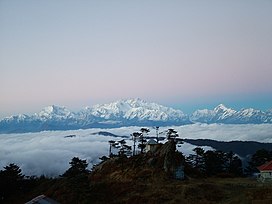Sandakphu
This articleneeds additional citations forverification.(January 2016) |
| Sandakphu | |
|---|---|
 View from Sandakphu in Darjeeling West Bengal | |
| Highest point | |
| Elevation | 3,636 m (11,929 ft) |
| Listing | List of Indian states and territories by highest point |
| Coordinates | 27°6′21″N88°0′6″E/ 27.10583°N 88.00167°E[2] |
| Geography | |
| Location | Darjeeling district,West Bengal,India; Ilam District,Koshi Province,Nepal |
| Parent range | Singalila Ridge |
| Topo map | Google topographic map[3] |
| Climbing | |
| Easiest route | Hiking or by car |

SandakphuorSandakpur(3636 m; 11,930 ft) is a mountain peak in theSingalila Ridgeon theborderbetweenIndiaandNepal.It is the highest point of the ridge and of the state ofWest Bengal,India. The peak is located at the edge of theSingalila National Parkand has a small village on the summit with a few hotels. Four of the five highest peaks in the world,Everest,Kangchenjunga,LhotseandMakalucan be seen from its summit. It also affords a pristine view of the entire Kangchenjunga Range. Sandakphu is also known as the land of poisonous flowers.
Etymology[edit]
The name derives from theTibeto-BurmanLepchalanguage and translates as "the height of the poisonous plant" - in reference to the former abundance at the locality (around a century ago) of the poisonous plantsAconitum feroxand certainRhododendronspecies. So great was the danger of fatal poisoning to sheep and cattle being driven through the area that they had to bemuzzledto prevent them grazing/browsing upon these toxic species (Aconitum feroxhas a good claim to being the most poisonous plant species in the world).[4][5]

Trekking[edit]
India[edit]

5miles
River
Wildlife Sanctuary
National
Park
CT: census town, R: rural/ urban centre, N: neighbourhood, H: hill centre, NP: national park/ wildlife sanctuary, TE: tea estate, TA: tourist attraction
Abbreviations used in names – TG for Tea Garden (town/village), TE for Tea Estate
Owing to space constraints in the small map, the actual locations in a larger map may vary slightly
The trek along the Singalila Ridge to Sandakphu andPhalutis one of the most popular in theEastern Himalayas,owing not only to the stupendous vistas of the Kangchenjunga and Everest ranges which it affords, but also to its seasonal wildflowers and opportunities forbirdwatching.Treks begin atManebhanjanwhich is 28 km (approx. 1 hour by road) from Darjeeling.[6]
Ascent[edit]
The Sandakphu Trekking routes inside the Singalila National Park have four legs or stages.
- Manebhanjan toMeghma(2600 m): This is a 4-hour trek through the lower forest. The route goes via Chitre.
- Meghma toGairibans(2621 m): There are two alternative trekking routes. They respectively go viaTonglu(3070 m) andTumling(2900 m). From Tumling, a shorter trail cuts through Nepal and Jaubari (2750 m). Jaubari is ward no 07 of jamuna VDC ilam.
- Gairibans to Sandakphu (3636 m):
- Sandakphu to Phalut (3600 m): It is a one-day trek via Sabarkum (3536 m) covering 21 km.
Descent[edit]
- Retracing the way back to Manebhanjan.
- A steep descent to the village of Sirikhola on the banks of the River Sirikhola, via Gurdum (2300 m), and from there toRimbick.
Panorama of Peaks seen from Sandakphu and Phalut[7]
Baruntse(7220m),Chamlang(7319m),Chomo Lonzo(7818m), Lhotse (8516m), Makalu (8462m), Mount Everest (8848m),Nuptse(7861m), Kanchenjunga (8586m), Talung (7349m), Rathong (6679m), Kabru N (7353m), Koktang (6147m), Simvo (6812m), Frey (5853m), Kabru S (7318m), Kabru Dome (6600m), Kabru Forked (6100m),Pandim(6691m), Tenchenkhang (6010m), Jupono (5650m)
Villages At Glance:Gorkhey, Bhareng, Gairibas, Meghma, Maneybhanjyang, Rammam, Srikhola, Sepi, Molley, Gurdum[7]
Nepal[edit]
The western part of Sandakphu peak is located inSandakpur rural municipality(ward no. 2 & 4) ofIlam DistrictofProvince No. 1.
The trekking starts fromIlam BazarviaMaipokhari,Maimajhuwa,Mabu,Kala Pokhri Bikhe Bhyanjyang to Sandakpur, and also from Ilam Bazar via Sulubung, Jamuna, Hangetham (a special area for birds such as thespiny babblerandblue tit), Piple, Kalipokhari, Bikhe Vanjyang to Sandakpur. On this trekking route, Jamuna is most valuable for trekkers. There are many beautiful places like Dhap Pokhari, Choyatar (special area forred pandas). There is a three jungle Hile Samudayik Ban, Choyatar Samudayik Ban, Hangetham Samudayik Ban.[clarification needed]
Gallery[edit]
-
Singalila Range andKanchenjunghaseen from Sandakpur
-
A panoramic view of Sandakpur.
-
Domestic yak(Bos grunniens)
-
View of Sandakphu from above
-
Sandakphu: shrub-clad rocky ridge with toxic, pink-floweredRhododendronspecies - for which it was (in part) named
References[edit]
- ^"The Journey to Sandakphu".ourguest.in.Retrieved23 April2024.
- ^Sandakphu Top - Wikimapia
- ^Google topographic map
- ^Rai, Lalitkumar and Sharma, EklabyarMedicinal Plants of the Sikkim Himalaya: Status, Uses and Potential,pub. Govind Ballabh Pant Inst. Bishen Singh & Mahendra Pal Singh 1994 pps 25-7.
- ^"Aconitum Ferox Monkshood Strongest Poisonous Plant".Archived fromthe originalon 4 June 2016.Retrieved13 May2016.
- ^,Sandakphu,Trek to Sandakphu, 1 August 2015Archived21 August 2015 at theWayback Machine
- ^ab"SANDAKPHU PHALUT TREK".
External links[edit]
- Mt Everest and Lhotse as seen from Sandakphu
- Your complete guide to Sandhakphu trekhttps:// ourguest.in/stories/your-complete-guide-to-sandakphu-trek
- In the Land of Sleeping Buddha - A Guide to Sandakphu Trek
- Land of the Land Rovers - Community fleet of 57 Series I in daily use from Maneybhanjang to the Sandakphu summit
- 20 Stunning Photos of Sandakphu
- Sandakphu Trek
- All About Sandakphu Trek: Where the Sky Meets the Earth






